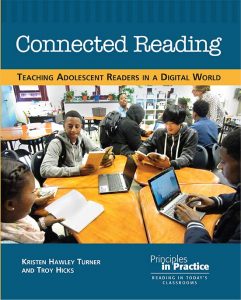The devices we turn to for information are vastly different from the ones we used a decade ago, so it makes sense that when we read today, we read differently.
The challenge facing educators then, is passing on the strategies and techniques that allow us to put digital texts to work for us, as well as print texts.
In a new book, Connected Reading: Teaching Adolescent Readers in a Digital World (National Council of Teachers of English, 2015) Kristen Hawley Turner, PhD, associate professor of English education and contemporary literacies in the Graduate School of Education, aims to do just that.
Along with her co-author Troy Hicks, PhD, associate professor of English at Central Michigan University, Turner collected data and interviewed hundreds of teens in 12 middle and high schools to get a sense of how and what teens read, and then came up with recommendations for helping them do it even better.
They found that while there are some teenagers who have developed digital reading skills on their own, most have not.
“They’re flailing out there in the Internet on their own, but they definitely need some support in learning how to be critical readers of digital texts,” Turner said.
The first step educators need to do is realize that, contrary to perceptions, technology is ubiquitous in both their classrooms and their students’ homes.
 “About 80 percent of students actually connect to the Internet every day, and the other 20 percent connect every day or several times a week outside of school, Turner said.
“About 80 percent of students actually connect to the Internet every day, and the other 20 percent connect every day or several times a week outside of school, Turner said.
“They’ve got the Internet in their pocket, so we can use that technology to get them online to do research, and to do more school related activities. We don’t necessarily have to get computers into the classroom.”
The biggest challenge that teens face is managing distractions. Often, they’re also unaware that if you search for the word “tiger” in Google, you’re likely to get different results in Michigan, where the Detroit Tigers are popular, than in New Jersey.
Recognizing that there are three practices that we all engage in with digital texts— encountering, engaging and sharing— can help teens overcome these challenges, said Turner.
Encountering can be passive, such as when we see a Facebook post, or it can be active, such as the aforementioned Google search. Engaging is when we decide to read an article, skip it, or save it for later via an RSS feed or other tools. Sharing can likewise be passive, such as a book review we share on Goodreads.com, or active, as when we e-mail stories to each other.
Turner says the book recognizes that we live in a “both/and” reading world.
“We have both print texts and digital texts. It’s not like we’re going to give up on those novels that you hold in your hand. But you can use those novels to develop connected readers,” she said.
She used herself as an example. While researching Connected Reading, she found a passage in a print book that she thought Hicks would be interested in. She snapped a picture of it with her smart phone, annotated the picture, and sent. Hicks was able to look up the same passage in his e-book version and copy it into their book.
She said that ultimately, they want to teach the importance of mindfulness, a concept they adapted from Clive Thompson’s book Smarter That You Think (Penguin Press, 2013)
“Right now I have about 15 tabs open on my computer, and any one of those can distract me from another,” she said. “So I have to develop the skills of mindfulness to know what my goals are in the moment, and really focus on those goals and keep other distractions at bay and move onto my next goal.”

